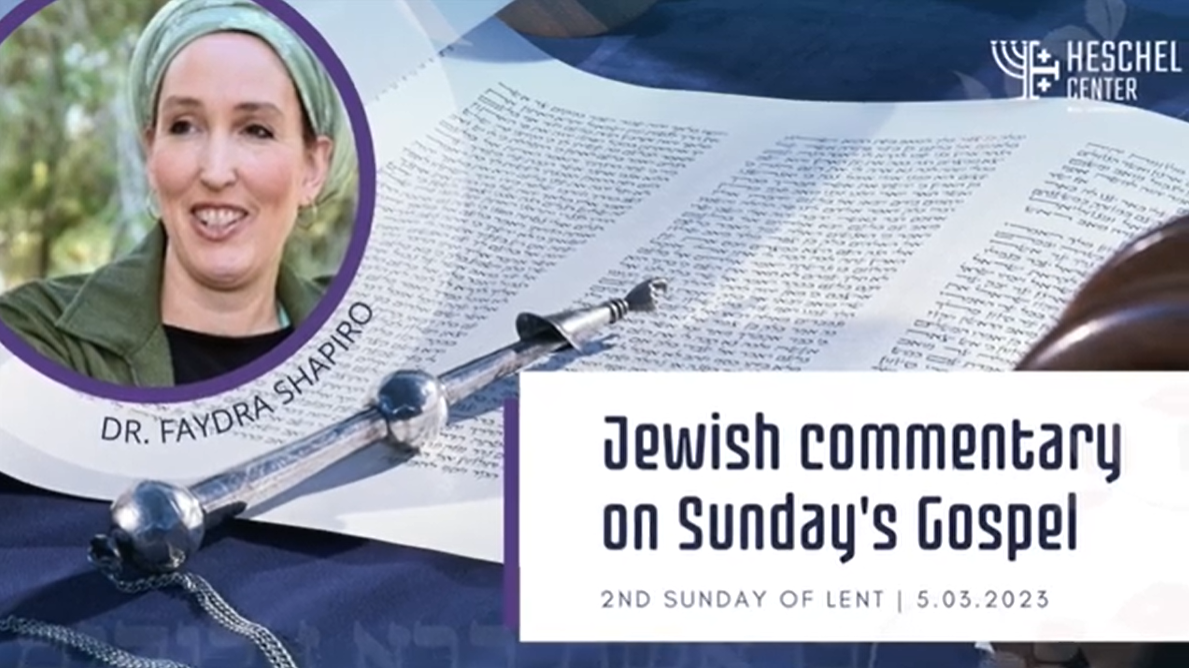Who was transfigured on Mount Tabor – the disciples or Jesus?


Photo credit: KUL Heschel Center
On the mountain, Peter and the disciples saw Jesus, Moses, and Elijah and Peter thought he had already understood everything. After a while, however, they heard the voice of God saying that Jesus was Someone unique, Someone “qualitatively different” from Moses and Elijah. It was only then that they raised their eyes and saw no one else but Jesus alone. Dr. Faydra Shapiro, Director of the Israel Center for Jewish-Christian Relations, writes about the non-accidental use of the biblical phrase “raise your eyes and see” and its meaning in a commentary for the Heschel Center of the Catholic University of Lublin.
This phrase, which repeatedly appears in the Hebrew Bible, is a clue to a deeper understanding of the passage in St. Matthew’s Gospel (Matthew 17:1-9) read on the Second Sunday of Lent. It is not enough to have eyes to see in the right way.
We publish the text of the Jewish commentary on the Gospel of the Second Sunday of Lent.
There’s a huge number of things we could talk about in this week’s Gospel reading in light of the Tanach – an embarrassment of riches one might say.
I want to focus on a tiny little piece of this text, one that I think is easily overlooked. And I use the term “overlooked” a bit cleverly, because I want to focus on looking and seeing.
We’re all familiar with the general story of the Jesus’ Transfiguration before Peter, James and John, and the sudden appearance of Moses and Elijah with him.
Now of course there are a lot of questions we might ask about the presence of Moses and Elijah. Why them? Were they really there? And if so, how could that be possible – according to Deuteronomy Moses died over a thousand years earlier. And Elijah appears not to have died at all but was assumed bodily into heaven on a chariot of fire.
Peter “sees” – or thinks he sees – the three of them: Jesus, Moses and Elijah. And he thinks he understands! He’ll build tabernacles for the three of them.
But clearly that’s the wrong answer here. Because God pronounces that Jesus is something unique, something qualitatively different than Moses and Elijah: This is my son in whom I am well pleased.
And when the disciples raised their eyes,
they saw no one else but Jesus alone.
At first glance we could think that this means that kind of “poof”, Moses and Elijah disappear. And perhaps that is indeed what happened.
But read against the background of the Hebrew Bible, it is extremely clear that the message here is something other than “they were here and now they’re not” statement of fact.
The hint is that they “raised their eyes and saw” – an expression with rich connotations in the Hebrew Bible.
In Genesis, Abraham lifted his eyes and saw the ram caught by his horns. Earlier God told Abraham to raise his eyes and see the Land that He will give to his descendants. The prophet Isaiah calls to us – “lift up your eyes to Heaven and see who created these” and to “raise our eyes to see” that the children thought lost to us are returned.
As we know – from Deuteronomy and Jeremiah and Psalms and Ezekiel – having eyes is not enough. And this language of having eyes but not really seeing is picked up in the New Testament in a couple of places. In fact Matthew has Jesus actually quote Isaiah about people who have eyes but cannot see, a few chapters before the Transfiguration in explaining why he needs to use parables! But, Jesus says, “Blessed are your eyes, for they see” (Mt 13,16).
To “lift up your eyes and see” is the language of seeing above and beyond what simply appears to our sight, data processed to our brains through the optic nerve. To lift up and see is the call to vision, to really see something rightly and know something with a deeper understanding.
So when the disciples lift up their eyes and see Jesus alone after the Transfiguration, this is not a statement about the exit of Moses and Elijah from the scene. Rather it is a teaching about seeing well – in a way that Peter wasn’t able to do immediately. Upon raising their eyes they saw Jesus alone. Not the “without any prophets standing beside Jesus” statement of fact, but the “seeing the singular and unique Jesus and none other.”
About the author
Dr. Faydra Shapiro is a specialist in contemporary Jewish-Christian relations and is the Director of the Israel Center for Jewish-Christian Relations. She received the National Jewish Book Award for her firs publication (2006). Her most recent book, together with Gavin d’Costa is Contemporary Catholic Approaches to the People, Land and State of Israel. Dr. Shapiro is also a Senior Fellow at the Philos Project and a Research Fellow at the Center for the Study of Religions at Tel Hai College in Israel.
The Desert – A Blessing or a Curse? >>>
KUL Heschel Center: Misunderstandings over the „eye for an eye” principle >>>
Law, Prophets, iota – we need to examine the context to understand the meaning of Jesus’ words >>>
Heschel Center KUL: What do salt, light and the city on a mountain mean to us? >>>
Heschel Center KUL: Why did the disciples, becoming „fishers of men,” abandon their nets? >>>
Hebrew Commentary to the Sunday Gospel excerpt – 2nd Sunday in Ordinary Time; Year A >>>
Jewish Commentary on the Gospel >>>
Hebrew commentary on the first Sunday of the New Year Gospel >>>
Jewish commentary on the Christmas Gospel >>>
Hebrew commentary on the Gospel for the Fourth Sunday of Advent >>>



Dodaj komentarz